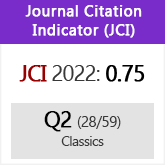Sobre los perfectos con HABER en griego Post-clásico y Bizantino temprano
DOI:
https://doi.org/10.3989/emerita.2013.08.1130Palabras clave:
griego antiguo, perfecto, perífrasis, diacronía, registroResumen
En este artículo analizo el uso y desarrollo de las construcciones perifrásticas de perfecto con el verbo ἔχω en el griego post-clásico y el bizantino temprano. Concretamente, examino las cuatro construcciones siguientes: (a) ἔχω con el participio aoristo activo/medio (anterior); (b) ἔχω con el participio de perfecto pasivo (resultativo); (c) ἔχω con el participio aoristo o presente pasivo (resultativo) y (d) ἔχω con el participio aoristo o presente activo/medio y complemento temporal (anterior). Mi análisis se basa en un corpus lingüístico variado, en el que distingo las obras de registros «bajo», «medio» y «alto».
Descargas
Citas
Aerts, W. J. 1965: Periphrastica, Amsterdam, Hakkert (diss. Amsterdam).
Bentein, K. 2011: «On the construction of HAVE with passive perfect participle in Greek and Latin», Eranos: Acta Philologica Suecana 106, pp. 65-76.
Bentein, K. 2012: «The periphrastic perfect in Ancient Greek. A diachronic mental space analysis», Transactions of the Philological Society 110, pp. 171-211. http://dx.doi.org/10.1111/j.1467-968X.2012.01289.x
Biber, D. and Conrad, S. 2009: Register, genre, and style, Cambridge, CUP. http://dx.doi.org/10.1017/CBO9780511814358
Bonfante, G. 1960: «Les rapports linguistiques entre la Grèce et l'Italie», in Hommages à Léon Herrmann, Bruxelles, Latomus, pp. 171-183.
Browning, R. 1969: Medieval and modern Greek, Cambridge, CUP.
Bybee, J., Perkins, R. and Pagliuca, W. 1994: The evolution of grammar, Chicago, University of Chicago Press.
Cameron, A. 1991: Christianity and the rhetoric of empire, Berkeley, University of California Press.
Coleman, R. 1975: «Greek influence on Latin syntax», Transactions of the Philological Society 74, pp. 101-156. http://dx.doi.org/10.1111/j.1467-968X.1975.tb01169.x
Comrie, B. 1976: Aspect, Cambridge, CUP.
Cox, P. 1983: Biography in Late Antiquity, Berkeley, University of California Press.
Croft, W. 2000: Explaining language change: An evolutionary approach, Harlow, Longman.
Croft, W. 2006: «The relevance of an evolutionary model to historical linguistics», in Nedergård Thomsen, O. (ed.), Different models of linguistic change, Amsterdam, John Benjamins, pp. 91-132.
Dickey, E. 2003: «Latin influence on the Greek of documentary papyri: An analysis of its chronological distribution», Zeitschrift für Papyrologie und Epigraphik 145, pp. 249-257.
Dickey, E. 2009: «The Greek and Latin languages in the papyri», in: Bagnall, R. S. (ed.), Oxford handbook of papyrology, New York, Oxford University Press, pp. 149-169.
Fleischman, S. 2000: «Methodologies and ideologies in historical linguistics: On working with older languages», in Herring, S. C., van Reenen, P. and Schøsler, L. (eds.), Textual parameters in older languages, Amsterdam, Benjamins, pp. 33-58. PMid:10828413
Gerö, E.-C. and von Stechow, A. 2003: «Tense in time: The Greek perfect», in Eckardt, R., von Heusinger, K. and Schwarze, C. (eds.), Words in time: Diachronic semantics from different points of view, Berlin, Mouton de Gruyter, pp. 251-294. http://dx.doi.org/10.1515/9783110899979.251
Giannaris, A. 2011a: «Pluperfect periphrases in Medieval Greek: A perspective on the collaboration between linguistics and philology», Transactions of the Philological Society 109, pp. 1-14. http://dx.doi.org/10.1111/j.1467-968X.2011.01277.x
Habermann, W. 1998: «Zur chronologischen Verteilung der papyrologischen Zeugnisse», Zeitschrift für Papyrologie und Epigraphik 122, pp. 144-160.
Haspelmath, M. 1992: «From resultative to perfect in Ancient Greek», in Iturrioz Leza, J. L. (ed.), Nuevos estudios sobre construcciones resultativas (= Función 7/11-12), Universidad de Guadalajara, Centro de Investigación de Lenguas Indígenas, pp. 187-224.
Haverling, G. 2009: «Actionality, tense, and viewpoint», in Cuzzolin, P. and Baldi, P. (eds.), New perspectives on historical Latin syntax, Berlin-New York, Mouton de Gruyter, vol. 2, pp. 277-523.
Høgel, C. 2002: Symeon Metaphrastes, Copenhagen, Museum Tusculanum Press. PMCid:PMC127431
Horrocks, G. 2010: Greek: A history of the language and its speakers, Oxford-Malden, Mass., Wiley-Blackwell.
Jannaris, A. 1897: An historical Greek grammar chiefly of the Attic dialect, Hildesheim, Olms.
Lampe, G. W. H. 1976: A patristic Greek lexicon, Oxford, Clarendon.
Lee, J. A. L. 2007: «᾿Eςαποστέλλω», in Joosten, J. and Tomson, P. J. (eds.), Voces Biblicae: Septuagint Greek and its significance for the New Testament, Leuven, Peeters, pp. 99-113.
Lehmann, C. 1995 [1982]: Thoughts on grammaticalization, München, Lincom Europa.
Liddell, H. G. and Scott, R. 1968⁹: A Greek-English lexicon, Oxford, Clarendon. PMCid:PMC1902210
Mandilaras, B. G. 1972: Studies in the Greek language, Athens, N. Xenopoulos Press.
Manolessou, I. 2008: «On historical linguistics, linguistic variation and Medieval Greek», Byzantine and Modern Greek Studies 32, pp. 63-79. http://dx.doi.org/10.1179/030701308X259679
Markopoulos, T. 2009: The future in Greek, Oxford, OUP.
Milroy, J. 1992: Linguistic variation and change, Oxford, Blackwell.
Mirambel, A. 1966: «Essai sur l'évolution du verbe en grec byzantin», Bulletin de la Société Linguistique de Paris 61, pp. 167-190.
Moser, A. 1988: A history of the perfect periphrases in Greek, Ph.D. Thesis, University of Cambridge.
Mufwene, S. 2001: The ecology of language evolution, Cambridge, CUP. http://dx.doi.org/10.1017/CBO9780511612862
Nettle, D. 1999: Linguistic diversity, Oxford, OUP. PMid:10077683 PMCid:PMC15941
O'Donnell, M. B. 2000: «Designing and compiling a register-balanced corpus of Hellenistic Greek for the purpose of linguistic description and investigation», in Porter, S. (ed.), Diglossia and other topics in New Testament linguistics, Sheffield, Sheffield Academic Press, pp. 255-297.
Pinkster, H. 1987. «The strategy and chronology of the development of future and perfect tense auxiliaries in Latin», in Harris, M. and Ramat, P. (eds.), Historical development of auxiliaries, Berlin, Mouton de Gruyter, pp. 193-223. http://dx.doi.org/10.1515/9783110856910.193
Porter, S. E. 1989: Verbal aspect in the Greek of the New Testament, New York, Peter Lang.
Romaine, S. 1982: Socio-historical linguistics: Its status and methodology, Cambridge, CUP. http://dx.doi.org/10.1017/CBO9780511720130
Ruijgh, C. 2004: «Over de gebruikswijzen van het Griekse perfectum. Met speciale aandacht voor Plato's Politeia», Lampas 37, pp. 24-45.
Salonius, A. H. 1927: Zur Sprache der griechischen Papyrusbriefe, Helsingfors, Akademische Buchhandlung.
Smyth, H. W. 1984 [1920]: Greek grammar, Harvard, Harvard University Press.
Tabachowitz, D. 1943: Études sur le grec de la basse époque, Uppsala, Almqvist & Wiksell.
Thielmann, P. 1891: «Ἐχω mit Particip», in Abhandlungen aus dem Gebiet der klassischen Altertums-Wissenschaft, München, Beck, pp. 294-306.
Traugott, E. and Dasher, R. 2002: Regularity in semantic change, Cambridge, CUP. Wolf, K. 1912: Studien zur Sprache des Malalas, München, Straub.
Descargas
Publicado
Cómo citar
Número
Sección
Licencia
Derechos de autor 2013 Consejo Superior de Investigaciones Científicas (CSIC)

Esta obra está bajo una licencia internacional Creative Commons Atribución 4.0.
© CSIC. Los originales publicados en las ediciones impresa y electrónica de esta Revista son propiedad del Consejo Superior de Investigaciones Científicas, siendo necesario citar la procedencia en cualquier reproducción parcial o total.Salvo indicación contraria, todos los contenidos de la edición electrónica se distribuyen bajo una licencia de uso y distribución “Creative Commons Reconocimiento 4.0 Internacional ” (CC BY 4.0). Puede consultar desde aquí la versión informativa y el texto legal de la licencia. Esta circunstancia ha de hacerse constar expresamente de esta forma cuando sea necesario.
No se autoriza el depósito en repositorios, páginas web personales o similares de cualquier otra versión distinta a la publicada por el editor.














